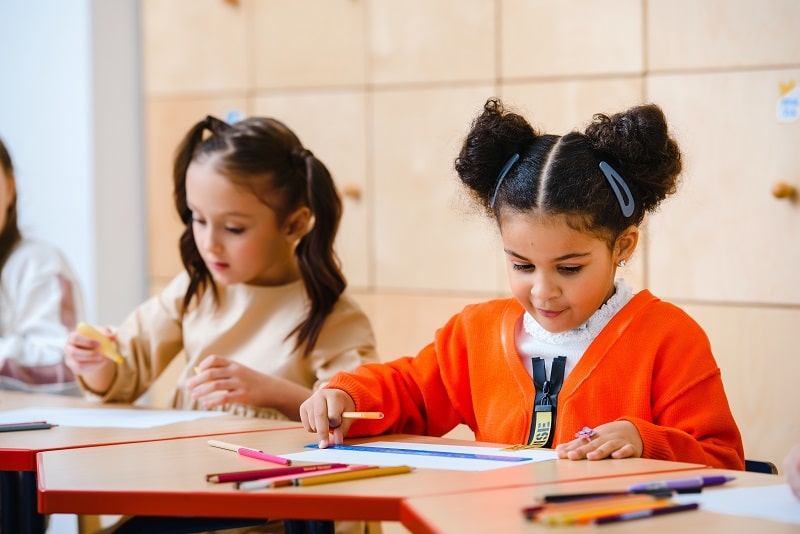2024 Kindergarten MAP Test Study Guide & Practice Test

In the United States, MAP (Measures of Academic Progress) testing is administered to students to gauge their academic abilities and levels of learning throughout the year.
The Kindergarten MAP test is often your child’s first exposure to MAP and standardized testing, and can therefore be stressful for both you and them.
Not only are they inexperienced when it comes to testing, but they may not have had much time to learn the content that will be tested – especially the maths portion.
Luckily, there are plenty of resources for the MAP test for Kindergarten students online to help you prepare your child for the test. We have put together this comprehensive guide to show you how to best prepare your child, and will cover:
- A breakdown of the maths and reading MAP tests
- How to prepare your child for the Kindergarten MAP reading and math tests
- Resources you can use to prepare your child
- Tips for passing the Kindergarten MAP tests
- Frequently asked questions regarding the Kindergarten MAP tests.
Let’s get into it!

Table of Contents
What Testing Is Used In Kindergarten?
The MAP exam was developed by NWEA, a nonprofit organization that generates evaluations for schoolchildren.
The MAP Kindergarten test is a computer-based and self-paced exam that measures students’:
- Math skills
- Reading skills
Typically, it’s given at three particular times annually to measure if kindergarten children learn at an appropriate pace with the curriculum presented to them during the school year.
The assessment considers that not all kids within this age category can read fluently; therefore, all questionnaires are audio-recorded, so for all intents and purposes, your kid can use a headset and listen to the questions as often as needed.
Furthermore, the exam extensively uses images to make it more likable and enjoyable for kindergarten students.
The MAP test for kindergarten has a structure in which the child progresses through the questions at the pace they feel comfortable with.
With each correctly answered question, the next generated question becomes more challenging. Consecutively, with each incorrectly answered question, the following question has a lowered complexity level than the previous one.
The MAP’s distinctive rating scheme considers the complexity tier and generates a test set unique to your kid and the abilities it presents during the testing.
TestPrep-Online and their informational article can give your more details about the NWEA MAP test.
What Sections Does The MAP Test For Kindergarten Have?
Kindergarten students are tested for two essential skills:
- Mathematics
- English language
Naturally, the complexity of the questions is lowered significantly so that the tests will check for appropriate abilities for the age.
The questions in the sections will measure abilities like recognition of letters, words, and numbers and the basic knowledge to approach word or numeral problems and devise a solution.
The next sections will detail the Reading and Math sections of the MAP kindergarten exam.
MAP Math Test For Kindergarten
Children begin to understand addition and simple arithmetic only 10 days after entering kindergarten, which, contrary to popular belief, is quite a significant achievement.
The Math section of the MAP test contains questions in these three main areas:
- Numeral
In this section, kindergarteners need to identify numbers from 1 to 10.
- Counting
In the counting sub-test, students will count, compare and order numerals from 1 to 10.
- Computations
In this section of MAP Math, students must solve mathematical word problems using basic operations and computational principles like addition, subtraction, equivalence, patterns, or series.
The Adaptive Sections for the Math MAP test for kindergarten are also for higher and lower complexity based on the proficiency shown by the student.
- For Numeral skills, the lower complexity level matches numerals from 1 to 10, while the higher complexity is the identification of numbers from 11 to 20.
- For Counting, the lower complexity is rote counting, while the higher complexity is one-on-one correspondence for numbers from 11 to 20.
- For Computations, the lower level is the identification of the number of objects (more than-less than), while the higher complexity level is computing with manipulatives, i.e., giving numerical answers to problems.
To receive a more in-depth explanation of the MAP Math test and its sections, head over to the NWEA MAP Math article.
Free Kindergarten Map Math Sample Questions
Sample questions are an excellent way for your kid to gain improved awareness of the MAP Kindergarten Exam, the varieties of questions, and how they are expected to answer them.
Additionally, sample questions help paint a much clearer image of your child’s current educational abilities and capacity for the development of academic learning success.
Image Courtesy: TestPrep-Online free sample questions
Image Courtesy: TestPrep-Online free sample questions
If you want to learn more about the MAP test for kindergarten, its sections, and what they measure, head over to TestPrep-Online and their thorough guide for the Kindergarten MAP test.
How To Prepare For The Math Test In Kindergarten?
You can find one of the most precise and complete Kindergarten MAP practice kits on TestPrep-Online to assist your kid in getting ready for their exam day.
The MAP Kindergarten Practice Pack contains the following:
- Six quizzes for each of the two MAP sections
The quizzes should support your child’s ability to concentrate on math and reading independently and significantly improve their comprehension of every topic.
There are various tiers of complexity for the tests, so your child can get used to the fact that on the testing day, some questions will be straightforward to answer, while others will require more time and effort.
- MAP test simulation
Such academic simulation studies’ goal is to subtly replicate the MAP testing setting. It will give your kid the most accurate educational learning simulation of the exam possible, allowing them to, for the most part, feel at ease and well-prepared for the big assessment event.
- Precise score reports and explanations
After each completed test or quiz, there will be a detailed explanation for the correct answer to each question. This part of the bundle ensures that your child doesn’t only practice but also learns through the quizzes he or she takes.
These detailed explanations for the correct answers are thorough and descriptive, providing your child with the correct answer and the logic of the solution. Your kid will gain knowledge of new approaches to thinking, generally understand their missteps, and perform well on the actual exam with the aid of all these explanations.
- MAP Learning Guide
The MAP study guide offers an overview of the MAP kindergarten exam, advice for acing the MAP kindergarten, and usage of the guidelines provided for the preparation test. The learning guide will help you learn and understand constructive ways to assist your child and ensure they are getting ready for the assessment.
Reading Test For Kindergarten
This testing section contains three main skills:
- Visual Discrimination i.e., Identification of letters;
Through visual discrimination, kindergarteners need to identify different words and sounds and understand the meaning and difference of vowels, consonants, or syllables.
- Phonological awareness, i.e., Rhyming words;
Understanding and controlling spoken words and sentences is known as phonological awareness. Identifying rhymes, recognizing alliteration, breaking down sentences into words, determining the number of syllables in a word, and blending and segmenting onset-rimes are a few examples.
- Various concepts of print, i.e., orientation on the page;
Through concepts of print, students need to understand and use concepts like the letters of the alphabet, the hierarchy of words, letters, and sentences; and the structure and characteristics of different prints (books, poetry, color books, etc.)
They should also be able to distinguish important elements of stories, like main characters, setting, and problems presented.
In theory, the higher and lower complexity of these questions is called Adaptive Sections.
There are more complex and less complex levels for each of the Reading section sub-categories.
- For Visual discrimination, the lower level is Visual discrimination of whole words, while the upper level is Matchings sounds to letters.
- For Phonological awareness, the lower level is Matching sounds, and the upper level is Manipulating Sounds.
- For Various compacts of Print, the lower level is Understanding pre-reading behaviors, and the upper level requires identifying the author/title or counting words.
If you’re looking for a more comprehensive guide about the reading section of the MAP, join TestPrep-Online and their NWEA MAP reading article. Please note that the details on their link include the overall reading proficiency levels for numerous grades, not just kindergarten.
How to Prepare for the Kindergarten MAP Reading Test
One of the best ways you can prepare your child for the MAP reading test is by having them engage in practice questions.
This will allow them to become familiar with the style of questions, as well as expose them to some of the concepts that will frequently come up in the tests.
The MAP Kindergarten Practice Pack from TestPrep that we mentioned earlier provides your child with all they need to prepare for the reading test.
It will provide a learning guide, as well as quizzes and test stimulation exercises with appropriate questions and topics to ensure that your child is sufficiently prepared for the test.
Outside of active test prep, you should also encourage your child to read as much as they can.
Ensuring that your child is frequently reading texts that will challenge them and expand their vocabulary is a good way to passively prepare them for the MAP test.
The more reading exposure they have had, the higher their level of comprehension and vocabulary will be.
Free Kindergarten MAP Reading Sample Questions
Various simulations and sample questions are available for kids to practice before the main exam. Here are some of the most common types of questions you and your kid can expect.
Image Courtesy: TestPrep-Online free sample questions
Image Courtesy: TestPrep-Online free sample questions
How Many MAP Assessments Are There?
It’s usually the school that decides what kinds of exams will kindergarten students take, but if they decided to go for MAP type of assessments, you could essentially choose between three types of exams:
- Screening – receiving primary data for a particularly young student in the early educational phase, i.e., just starting preschool or kindergarten.
- MAP Growth English or Spanish – a test created to monitor each learner’s performance using an academic learning method. The exam, in particular, has a proven track record for identifying gifted skills and talents and defining readiness for the upcoming semester. A strong performance on the MAP Growth Test may give your child the advantage they need to achieve academic excellence later at school.
- Skills Checklist – evaluating proficiency in a specific talent/area/skill in Math and English language before or during learning that particular area.
Throughout our article, we refer to the MAP Growth test since the other two tests are either specified area assessments or are given only at the beginning of preschool.
How Many Questions Are There On The MAP Test For Kindergarten?
Both the reading and the math portion of the MAP test will contain 43 questions.
The exact style and content of the questions will vary depending on the region and your child’s school district.
Furthermore, the complexity of the questions will vary depending on the proficiency your child displays during testing.
How Long Does The MAP Test For Kindergarten Last?
The fairly average kindergartener needs between 45 and 55 minutes to fully finish a MAP Growth exam. MAP Growth is not time restricted, so students are able to take as long as they require to complete the exam.
Is The MAP Test For Kindergarten Hard?
The MAP exam for kindergarten has a complexity level that adapts to the child and their portrayed proficiency.
If the child has incorrectly answered four or more consequent questions, the sub-skill section questions will decrease in complexity.
If the child has more than 4 or 5 correct answers, the next section of sub-skills will increase in complexity.
Why Are Kindergarten Kids Tested?
Tests in kindergarten don’t follow the regular school system of grading. Even though they get tests, the point of those assessments is not to quantitatively grade the kindergarten students but to qualitatively check if they can follow the curriculum and keep up with the learning pace.
The MAP kindergarten test is one of those assessments used to assess kindergarten children’s skills and abilities as they move through the material.
Map Kindergarten Test Scores for 2023
In contrast to standardized assessments, MAP Growth is given at regular intervals throughout the academic year. Each student gets questions adapted to the knowledge they’ve presented.
The MAP test scores are more efficiently used to measure the progress your student makes as the school year moves forward and are not suitable to compare peers or national standards.
What Does The RIT Score Mean?
The Rasch unIT (RIT) scale is the foundation for the NWEA MAP Growth scoring scheme. This measurement offers a three-tier scoring frequency that monitors the child’s aptitude and development with the range of topics covered by the exam.
Each test question has an RIT value that mirrors its complexity. The kids will obtain independent RIT scores for every section of the MAP assessment in addition to their overall RIT score, allowing them to identify their strong and weak points.
Scores For MAP Kindergarten Math Test
Low Threshold (5th to 31st percentile) – from 119 to 133 points
Median Threshold (50th percentile) – around 140 points
High Threshold (69th to 90th Percentile) – 146 to 160 points
Scores for MAP Kindergarten Reading Test
Low Threshold (5th to 31st percentile) – from 117 to 131 points
Median Threshold (50th percentile) – around 137 points
High Threshold (69th to 90th Percentile) – from 143 to 157 points
What Is The Average MAP Test Score?
Test | Fall | Winter | Spring |
MAP Reading | 136.65 | 146.28 | 153.09 |
MAP Math | 139.56 | 150.13 | 157.11 |
Source: NWEA
The average MAP test score can vary depending on the time it was taken.
According to the latest data collected in 2020, average MAP Reading scores for Kindergarten were 136.65 for Fall, 146.28 for Winter, and 153.09 for Spring.
The same data has shown that the average MAP Math scores for Kindergarten were 139.56 for Fall, 150.13 for Winter, and 157.11 for Spring.
What Is the highest MAP test score?
The maximum number of points that a child can get on the MAP test for kindergarten is 157 for MAP Reading and 160 for Math MAP. Nonetheless, students usually get around 137 for MAP Reading and 140 for MAP Math, which is the median, average threshold.
Tips for Passing the Kindergarten MAP Reading Test
Prepare and practice
The best way to give yourself a chance at passing any test in life is to be adequately prepared.
The same goes for preparing your child for the MAP reading test.
By using online materials that acclimate your child to the style of question and solidify the knowledge that they will be required to draw upon during the test, you are placing them in the best position possible to pass the test with flying colors.
Minimize stress
Children are highly sensitive to stress and pressure, and while you may be worried that your kindergartener may not pass or do well on the test, it is important that you try to prevent your child from feeling the same way.
This ensures that they are calm, relaxed, and have a stress-free approach to their learning journey.
A lack of stress or anxiety will help them on test day to stay calm and perform to the best of their abilities.
Encourage wider reading
MAP resing test preparation does not have to be limited to actual
Reading is one of those skills that improves no matter how or when you do it. If you want to give your child that extra boost to ensure that they pass the test, ensure that they are reading outside of test preparation. 1
This could be as simple as reading with you before bed or encouraging solo reading that you oversee.
Reading widely will allow them to become more familiar with comprehension words and will expand their vocabulary – two skills that are highly important for the MAP test.
Use incentives to meet goals
If you’re struggling to get your child to prepare for their test, try using an incentive-based system.
Working towards a treat or reward will encourage your child to engage in their learning and make the whole process a lot more fun.
This may increase their level of preparedness, which in turn will give them a better chance at passing the test.
Conclusion
Most kids may experience fear, high anxiety, and hesitancy before their first official classroom exam, mainly if they are still young and playful. The MAP test might be that experience for your child, so it’s essential to ensure they get academically and mentally prepared.
This article detailed everything you need to know about the MAP test for kindergarteners. We also provided sample questions and thoroughly explained the MAP test subjects and the measured academic areas.
In the end, we also recommended TestPrep-Online, the best and most extensive online library for MAP practice materials and MAP test preparation.
Frequently Asked Questions About the Kindergarten Map Test
How can parents access their child’s Kindergarten MAP test results?
In order to access your child’s MAP test results, they will need to be provided to you by their school or kindergarten.
Most educational facilities provide parents with the MAP Growth Family Report which will contain their child’s test scores.
How long does the Kindergarten MAP test take to complete?
The test is technically untimed, and the child is allowed as long as they need to complete the test. However, most children take around 45 minutes to complete each test.
Is the Kindergarten MAP test mandatory for all students?
The MAP tests are standardized. This means that it is likely that it is mandatory for your Kindergartener if they are in the public school system.
Can the Kindergarten MAP test be retaken?
The Kindergarten MAP tests are administered three times a year – in the Fall, Winter, and Spring. This means that your child technically retakes the test an additional two times after the first.
However, this means it is rare that your child will be able to retake the Kindergarten MAP test within the same administration period.
What accommodations are made for non-native English speakers?
For both the Kindergarten MAP reading and math tests, your child can opt to take the Spanish version of the test.
This is an accommodation that was introduced by NWEA in order to support students who are not native English speakers.
What accommodations are made for students with special needs?
NWEA has a comprehensive list of accommodations allowed during the Kindergarten MAP test for children with special needs.
These include having a human reader, the ability to take breaks, refreshable braille, and a magnification device for those who struggle with vision.
Sarah is an accomplished educator, researcher and author in the field of testing and assessment. She has worked with various educational institutions and organisations to develop innovative evaluation methods and enhance student learning. Sarah has published numerous articles and books on assessment and learning. Her passion for promoting equity and fairness in the education system fuels her commitment to sharing insights and best practices with educators and policymakers around the world.











